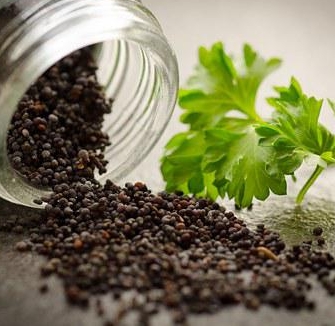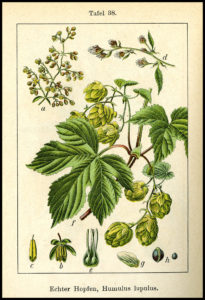Ever Wondered Why Beer Makes You Feel Tired?
It might just be the hops. This iconic beer ingredient isn’t only responsible for the flavor and preservation—it’s long been prized as a gentle herbal sedative.
Used since at least the 11th century, hops have been traditionally added to brews not only for flavor and preservation, but also for their calming effects. IPAs, or India Pale Ales, famously include double the hops to prevent spoilage during long voyages to India.
In earlier centuries, nursing mothers were often given beer—hop-infused, of course—to support milk production and encourage relaxation, which supports healthy lactation.
Beyond beer, hops themselves are a valuable remedy:
- They soothe spastic digestive discomfort, especially when nerves are involved.
- A cup of hop tea or a few drops of a tincture can gently lull the nervous system into rest.
- Their cooling and estrogen-like (phytoestrogenic) qualities help ease menopausal symptoms like hot flashes.
- These estrogenic effects, combined with sedative action, may lower sex drive in men (making beer perhaps less ideal for late-night amorousness, but perfect for winding down after a long day).
MATERIA MEDICA
Latin Name: Humulus lupulus
Family: Cannabaceae
Part Used: Strobiles (hop cones)
Energetics: Bitter, cool, pungent
Actions:
Anodyne, antibacterial, anti-inflammatory, antiseptic, antispasmodic, cholagogue, diuretic, febrifuge, galactagogue, nervine, relaxant, sedative, soporific, stomachic, phytoestrogenic
Uses:
- Encourages breast milk production
- Promotes restful sleep
- Stimulates liver and bile flow
- Acts as a digestive bitter
- Decreases sexual desire in men
- Offers menopausal symptom relief
- Serves as a topical antibacterial wash and deodorant
Preparation & Dosage
- Tea: Best used in blends, as hops can be intensely bitter. Pair with herbs like valerian or fennel for bedtime or lactation support.
- Tincture: 30–60 drops, three times daily.
- Cautionary Notes: Avoid excessive use during pregnancy or breastfeeding—its phytoestrogen effects on infants are untested. Men concerned about fertility should steer clear.
Herbal Highlights & Modern Insights
Sedative and Nervine Effects
- Hops are known as mild sedatives, often recommended in cases of insomnia or nervous exhaustion. Their calming effects are enhanced when combined with herbs like valerian or lemon balm [3].
- Historically, hops were used in herbal pillows to promote sleep—many still use them that way today [10].
Mechanism of Action
-
The sedative effect seems tied to hops resin (lupulin), rich in alpha-acids, beta-acids, and essential oils that interact with GABA neurotransmission—promoting relaxation and sleep [4].
Phytoestrogenic Activity
-
Hops contain 8-prenylnaringenin, one of the most potent phytoestrogens known. This makes hops useful in alleviating menopausal symptoms like hot flashes—though precaution is advised, especially in estrogen-sensitive conditions [6, 22].
Digestive & Metabolic Uses
- Their bitter and aromatic nature supports digestion, bile flow, and appetite [11].
- Some studies suggest hops may support metabolic and endothelial health by reducing inflammation and improving cholesterol profiles—but more research is needed [11].
References
- Rowan + Sage. (n.d.). Materia medica: Hops. Retrieved from https://community.rowanandsage.com/c/materiamedica/hops
- Herbal Academy. (n.d.). Hop monograph. The Herbarium, The Herbal Academy. Retrieved from https://herbarium.theherbalacademy.com/monograph/hop/
- PeaceHealth. (n.d.). Hops – Health Information Library. Retrieved from https://www.peacehealth.org/medical-topics/id/hn-2108006
- Restorative Medicine. (n.d.). Hops Monograph. Retrieved from https://restorativemedicine.org/library/monographs/hops/
- EBSCO CAM Review Board. (2024). Hops’ therapeutic uses. Retrieved from EBSCOhost
- NCBI. (2018). Therapeutic Perspectives of 8-Prenylnaringenin. Retrieved from https://pmc.ncbi.nlm.nih.gov/articles/PMC6017581/
- NCBI. (n.d.). Flavonoids as Phytoestrogenic Components of Hops. Retrieved from https://pmc.ncbi.nlm.nih.gov/articles/PMC7570471/
- Verywell Health. (2011). Do Hops Have Health Benefits? Retrieved from https://www.verywellhealth.com/the-health-benefits-of-hops-89058
- Drugs.com. (2024, November 20). Hops. Retrieved from https://www.drugs.com/npp/hops.html
- Springer. (2021). Hop (Humulus lupulus L.): Traditional and Present Use. Retrieved from https://link.springer.com/article/10.1007/s12231-021-09528-1
- HerbRally. (n.d.). Hops Monograph. Retrieved from https://www.herbrally.com/monographs/hops
- Healthline. (2013). Can Hops Help You Sleep? Retrieved from https://www.healthline.com/health/can-hops-get-me-to-sleep
- Wikipedia. (2025). Hops. Retrieved from https://en.wikipedia.org/wiki/Humulus_lupulus
- Wikipedia. (2023). 8-Prenylnaringenin. Retrieved from https://en.wikipedia.org/wiki/8-Prenylnaringenin
- ArXiv. (2024). Nature’s Brewery to Bedtime: The Role of Hops in GABAA Receptor Modulation. Retrieved from https://arxiv.org/abs/2402.02129
Browse by category
- Aphrodisiacs
- Aromatherapy
- Astrology & Magic
- Ayurdeva
- Botany Foraging & Gardening
- Chakras
- Digestion
- Earth Connection
- Energetics
- Flower & Gem Essences
- Folk Traditions
- Herbalism & Holistic Health
- Immune Support
- Materia Medica
- Mushrooms
- Nutrition
- Seasonal Living: Autumn
- Seasonal Living: Moon Cycle
- Seasonal Living: Spring
- Seasonal Living: Summer
- Seasonal Living: Winter
- Skin & Body Care

Don’t Miss a Thing!
Enter your email below to be the first to know about sales, new products and tips for taking care of your pieces.


